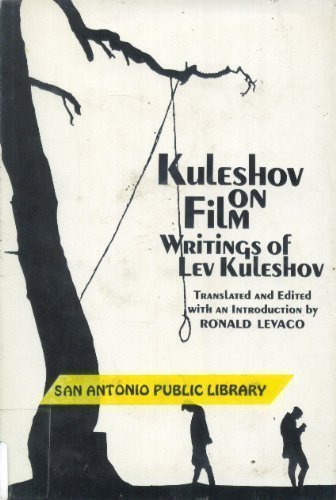Kuleshov on Film: Writings by Lev Kuleshov ebook download
Par seay andrew le vendredi, septembre 2 2016, 00:56 - Lien permanent
Kuleshov on Film: Writings by Lev Kuleshov. Lev Vladimirovich Kuleshov, Ronald Levaco

Kuleshov.on.Film.Writings.by.Lev.Kuleshov.pdf
ISBN: 0520026594,9780520026599 | 121 pages | 4 Mb

Kuleshov on Film: Writings by Lev Kuleshov Lev Vladimirovich Kuleshov, Ronald Levaco
Publisher: Univ of California Pr
Lev Kuleshov and also Sergei Eisenstein were two film makers (both Russian) to really step this up. She explains it this way: "Lev Kuleshov, a Russian filmaker, edited a short film using static images of an actor's face alternated with shots of a plate of soup, a girl at play, and a coffin. Lev kuleshov was among the very first to theorise about the relatively young medium of the cinema in the 1920s. It has to do with context and editing, and how the placement of images can affect perception. Lev Kuleshov was an early Soviet director, possibly one of the first film theorists of montage, who worked prior to Eisenstein's appearance in film. After seeing the montage, that would change the perception, or increase the emotion that a reader imagines? Alexandra Kokhlova (Eidth Nelson), Sergei Komarov (Hans Nelson), Vladimir Fogel influence on the development of montage under Kuleshov and Eisenstein. Flicker Alley's “Landmarks of Early Soviet Film” is a box set of eight remastered titles from the Soviet cinema's most exuberantly experimental period comprised of two fiction films by Lev Kuleshov, “The Extraordinary Adventures of Mr. The Kuleshov Effect is the result of a very famous film experiment done by Lev Kuleshov in the 1910s and 1920s. These three films and four others are showing at Facets Cinematheque this week, along with a film Barnet acted in (Lev Kuleshov's 1924 knockabout farce The Extraordinary Adventures of Mr. By the time he came to make his most famous and best film, By the Law, it was no surprise he turned to another American, Jack London, for his inspiration. Lev Kuleshov was an early 20th century Soviet filmaker, the first aesthetic theorist of film, the man behind the montage. Three pairs of images from the film experiment carried out by the Russian psychologist Lev Kuleshov around 1920. Montage is a synonym for a form of editing which was practiced by Soviet filmmakers Lev Kuleshov, Vesvolod Pudovkin, Dziga Vertov and Sergei Eisenstein around the 1920s at the Kuleshov school of film-making. Po Lakonu by Lev Kuleshov: Better known for an eponymous montage principle than for his too-rarely-seen films, Kuleshov momentarily set aside his avant-garde proclivities with this 1926 screen adaptation of Jack London's The Unexpected. In this classic interview with Alfred Hitchcock he demonstrates the Kuleshov Effect. D Lev Kuleshov w Lev Kuleshov, Viktor Shkovsky story “The Unexpected” by Jack London ph Konstantin Kuznetsov ed Lev Kuleshov art Isaak Makhalis. Classically, it's basically what editing is about in film; you create meaning by placing shots next to each other and then watch as they influence each other. Cowritten with Viktor Shklovsky, and featuring Aleksandra Khoklova I'll be writing more about this film here in the not-too-distant future. This is a film editing montage effect named after Russian filmmaker Lev Kuleshov who first illustrated it in the 1910s and 1920s.